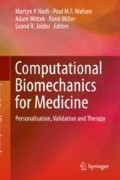Abstract
Non-invasive methods for estimating carotid artery (CA) pressure waveforms have been recently developed as a tool to detect heart abnormalities. Among non-invasive techniques, camera-based methods have the advantage of being non-contact, which enables measurements without applying external pressures to the artery. Camera-based methods measure skin deformation waveforms caused by arterial blood flow, which are assumed to have a similar shape to the pressure waveforms. Video recordings of the subject’s neck are analysed to quantify skin deformations caused by the carotid pressure pulse. However, in practice, unrelated motion, such as the relative movements of the camera and the subject, or movements due to breathing, can confound the skin measurements. One of the primary effects of this error is seen in the form of signal drift, which can make it difficult to analyse the shape of the skin displacement waveform. In this paper, we have investigated and compared two methods for removing the signal drift. One is to correct for the motion in the captured videos of the neck, and the second method is to use a high-pass wavelet filter. The results showed that, although both methods could reduce the signal drift, they had dissimilar effects on the shape of the CA displacement waveforms. The high-pass wavelet filter seemed to preserve the original measured shape of the CA displacement waveforms better than the motion-correction method. However, in this study, it was not possible to quantify the performance since the true shape of the CA displacement waveforms was not known.
Access this chapter
Tax calculation will be finalised at checkout
Purchases are for personal use only
References
Townsend N, Wilson L, Bhatnagar P, Wickramasinghe K, Rayner M, Nichols M (2016) Cardiovascular disease in Europe: Epidemiological update 2016. Eur Heart J 37:3232–3245
Kasznicki J, Drzewoski J (2014) Heart failure in the diabetic population – pathophysiology, diagnosis and management. Arch Med Sci 3:546–556
DeSilva, R (2013) Heart disease. Biographies of disease. Greenwood, Oxford. https://books.google.co.nz/books?id=JgWb1QzudRMC
Maganti K, Rigolin VH, Sarano ME, Bonow RO (2010) Valvular heart disease: diagnosis and management. Mayo Clin Proc 85:483–500
O’Rourke MF, Pauca A, Jiang X-J (2001) Pulse wave analysis. Br J Clin Pharmacol 51:507–522
Amelard R, Hughson RL, Greaves DK, Pfisterer KJ, Leung J, Clausi DA, Wong A (2017) Non-contact hemodynamic imaging reveals the jugular venous pulse waveform. Sci Rep 7:1–10
Moco AV, Mondragon LZ, Wang W, Stuijk S, De Haan G (2017) Camera-based assessment of arterial stiffness and wave reflection parameters from neck micro-motion. Physiol Meas 38:1576–1598
HajiRassouliha A, Lam Po Tang E, Nash MP, Taberner AJ, Nielsen PMF, Cakmak YO (2017) Quantifying carotid pulse waveforms using subpixel image registration. In: Computational biomechanics of medicine XII workshop, MICCAI
HajiRassouliha A, Taberner AJ, Nash MP, Nielsen PMF (2018) Subpixel phase-based image registration using Savitzky–Golay differentiators in gradient-correlation. Comput Vis Image Underst 170:28–39
HajiRassouliha A, Taberner AJ, Nash MP, Nielsen PMF (2016) Subpixel measurement of living skin deformation using intrinsic features. In: Proceedings of computational biomechanics of medicine XI workshop, MICCAI
Daubechies I (1988) Orthonormal bases of compactly supported wavelets. Commun Pure Appl Math 41:909–996
HajiRassouliha A, Taberner AJ, Nash MP, Nielsen PMF (2017) Motion correction using subpixel image registration. In: Proceedings of international workshop on reconstruction and analysis of moving body organs, MICCAI, pp 14–23
Mallat SG (1989) A theory for multiresolution signal decomposition: the wavelet representation. IEEE Trans Pattern Anal Mach Intell 11:674–693
Lei L, Wang C, Liu X (2013) Discrete wavelet transform decomposition level determination exploiting sparseness measurement. Int J Electr Comput Energy Electron Commun Eng 7:691–694
HajiRassouliha A, Amoon M, Doostmohammadi MH, Sadr A, Ayatollahi A, Rezairad GA (2008) Comparison of using different types of wavelet or FFT for de-nosing of body surface potential signals. In: 2008 third international conference on broadband communications, information technology & biomedical applications. IEEE, pp 233–238
Subasi A (2007) EEG signal classification using wavelet feature extraction and a mixture of expert model. Expert Syst Appl 32:1084–1093
Amin HU, Malik AS, Ahmad RF, Badruddin N, Kamel N, Hussain M, Chooi W-T (2015) Feature extraction and classification for EEG signals using wavelet transform and machine learning techniques. Australas Phys Eng Sci Med 38:139–149
Author information
Authors and Affiliations
Corresponding author
Editor information
Editors and Affiliations
Rights and permissions
Copyright information
© 2020 Springer Nature Switzerland AG
About this paper
Cite this paper
Lam Po Tang, E.J., HajiRassouliha, A., Nash, M.P., Taberner, A.J., Nielsen, P.M.F., Cakmak, Y.O. (2020). Removing Drift from Carotid Arterial Pulse Waveforms: A Comparison of Motion Correction and High-Pass Filtering. In: Nash, M., Nielsen, P., Wittek, A., Miller, K., Joldes, G. (eds) Computational Biomechanics for Medicine. Springer, Cham. https://doi.org/10.1007/978-3-030-15923-8_9
Download citation
DOI: https://doi.org/10.1007/978-3-030-15923-8_9
Published:
Publisher Name: Springer, Cham
Print ISBN: 978-3-030-15922-1
Online ISBN: 978-3-030-15923-8
eBook Packages: EngineeringEngineering (R0)

